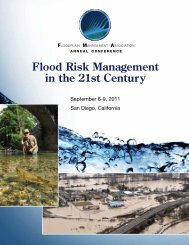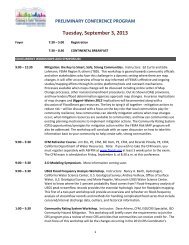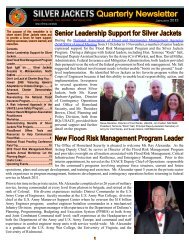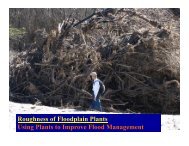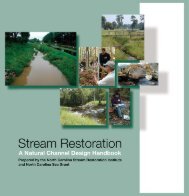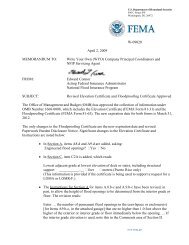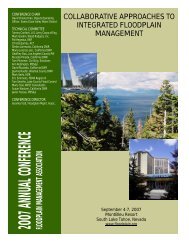Using Multi-Objective Management to Reduce Flood Losses in Your
Using Multi-Objective Management to Reduce Flood Losses in Your
Using Multi-Objective Management to Reduce Flood Losses in Your
You also want an ePaper? Increase the reach of your titles
YUMPU automatically turns print PDFs into web optimized ePapers that Google loves.
No net loss: A term used <strong>in</strong> wetlands protection and res<strong>to</strong>ration programs <strong>to</strong><br />
signify the <strong>in</strong>tent <strong>to</strong> reduce the cumulative impact of wetland losses. No net loss<br />
determ<strong>in</strong>ations may be based on acreage and/or the functional value of wetlands.<br />
NOAA: U.S. Department of Commerce, National Oceanic and Atmospheric<br />
Adm<strong>in</strong>istration.<br />
Nonpo<strong>in</strong>t source pollution: Water pollution that orig<strong>in</strong>ates from diffuse sources,<br />
such as ra<strong>in</strong>fall runoff or snowmelt.<br />
Nonstructural measures: Techniques, such as regulations, acquisition, and<br />
floodproof<strong>in</strong>g, that modify susceptibility <strong>to</strong> flood<strong>in</strong>g, as opposed <strong>to</strong> structural<br />
methods that modify flood<strong>in</strong>g, like dams and levees.<br />
Noreaster or Northeaster: On the U.S. East Coast, a s<strong>to</strong>rm whose<br />
counterclockwise w<strong>in</strong>ds approach the shore from the northeast.<br />
NPDES: The National Pollutant Discharge Elim<strong>in</strong>ation System, a program<br />
managed by the U.S. Environmental Protection Agency <strong>to</strong> improve water quality.<br />
Larger bus<strong>in</strong>esses must work <strong>to</strong> improve the quality of s<strong>to</strong>rmwater runoff <strong>in</strong> order<br />
<strong>to</strong> get NPDES permits.<br />
NPS: U.S. Department of the Interior, National Park Service<br />
NRCS: U.S. Department of Agriculture, Natural Resources Conservation<br />
Service.<br />
NWS: National Weather Service.<br />
One percent chance flood: See “base flood.”<br />
Po<strong>in</strong>t source pollution: Water pollution that is discharged from a discrete<br />
location, such as a pipe, tank, pit, or ditch.<br />
Pond<strong>in</strong>g: A flood<strong>in</strong>g condition <strong>in</strong> flat areas caused when ra<strong>in</strong> runoff dra<strong>in</strong>s <strong>to</strong> a<br />
location that has no ready outlet. Pond<strong>in</strong>g water usually stands until it evaporates,<br />
seeps <strong>in</strong><strong>to</strong> the ground, or is pumped out.<br />
Post-FIRM: Constructed after the date of the community’s <strong>Flood</strong> Insurance Rate<br />
Map.<br />
Pre-FIRM: Constructed before the date of the community’s <strong>Flood</strong> Insurance Rate<br />
Map.<br />
Repetitive loss structure: A build<strong>in</strong>g that has <strong>in</strong>curred two or more losses of<br />
more than $1,000 over a specified period of time, usually over the last 10 years.<br />
Retrofitt<strong>in</strong>g: Techniques, such as floodproof<strong>in</strong>g, elevation, construction of small<br />
levees, and other modifications, made <strong>to</strong> an exist<strong>in</strong>g build<strong>in</strong>g or its yard <strong>to</strong> protect<br />
it from flood damage.<br />
C-5





